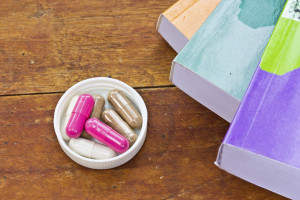Category: News Tags: , ADHD medication abuse
 ADHD stimulants belong to a group of medications that ease the effects of attention-deficit/hyperactivity disorder by increasing the ability to focus, pay attention and stay calm. The two best-known forms of these medications are Adderall and Ritalin. As part of a larger survey on substance use trends among American teenagers, researchers from the University of Michigan looked at the number of teens using either one of these medications improperly in 2013. The researchers concluded that the rate of Ritalin and Adderall abuse among U.S. adolescents remained comparable to the rate reported in 2012.
ADHD stimulants belong to a group of medications that ease the effects of attention-deficit/hyperactivity disorder by increasing the ability to focus, pay attention and stay calm. The two best-known forms of these medications are Adderall and Ritalin. As part of a larger survey on substance use trends among American teenagers, researchers from the University of Michigan looked at the number of teens using either one of these medications improperly in 2013. The researchers concluded that the rate of Ritalin and Adderall abuse among U.S. adolescents remained comparable to the rate reported in 2012.
What Are ADHD Stimulants?
ADHD stimulant medications can contain either amphetamine-based or non-amphetamine-based substances as their active ingredients. Adderall, for example, contains a combination of amphetamine and a closely related substance called dextroamphetamine. Ritalin, on the other hand, contains methylphenidate, a substance that doesn’t belong to the amphetamine family. Whatever their specific chemical origin, ADHD stimulants achieve their effects by speeding up the normal level of interaction between the nerve cells that power the brain. In people who don’t have attention-deficit/hyperactivity disorder, this increase in cell interaction may serve no legitimate medical purpose. However, in ADHD-affected individuals, it can significantly reduce the disruptive power of hyperactive behaviors, impulsive behaviors or an inability to focus or pay attention.
ADHD stimulant abuse can occur among both prescribed users of these medications and people unaffected by ADHD. High school students and college students, in particular, are noted for their misuse of stimulant medications as “study drugs” in a misguided effort to boost their ability to perform well academically. As is true with all strong stimulants, misuse of these medications can lead to the onset of chemical dependence and addiction if the brain starts to view the presence of amphetamine-based or non-amphetamine-based substances as part of its “normal” operating conditions.
Previous Trends in ADHD Drug Use
The survey conducted by the University of Michigan is called Monitoring the Future. This annual National Institute on Drug Abuse-funded project gathers information from a selectively chosen group of 40,000 to 50,000 12th, 10th and 8th graders attending school throughout the U.S. It then uses the gathered information to predict trends in substance use (and attitudes on substance use) among American teenagers in general. Monitoring the Future specifically tracks trends for both Adderall and Ritalin abuse. In 2012, 4.4 percent of all 12th, 10th and 8th graders abused Adderall at least once. The highest rate of abuse (7.6 percent) occurred among 12th graders; the lowest rate (1.7 percent) occurred among 8th graders. The rate of Adderall abuse among 10th graders was almost exactly halfway between these two extremes. Only 1.7 percent of all teenagers in the three selected grades abused Ritalin at least once in 2012. The highest rate (2.6 percent) occurred among 12th graders; the lowest rate (0.7 percent) occurred among 8th graders.
Current Trends in ADHD Drug Use
In 2013, the rate of Adderall abuse among U.S. 12th graders fell by a statistically insignificant 0.2 percent. The rate of Adderall abuse among 10th graders and 8th graders also fell by a small, statistically insignificant amount. The rate for Ritalin abuse among 12th graders fell from 2.6 percent to 2.3 percent between 2012 and 2013. Among 10th graders, the rate fell from 1.9 percent to 1.8 percent; among 8th graders, it rose a little from 0.7 percent to 1.1 percent.
Monitoring the Future also probed the attitudes that teenagers have toward the misuse of Adderall. The results of the survey indicate that roughly 28 percent of all 8th graders view the occasional misuse of this medication as risky or dangerous; between 16 and 17 percent of 8th graders felt the same way about brief experimentation with Adderall abuse. A little over 30 percent of all 10th graders currently view occasional Adderall abuse as dangerous, while between 17 and 28 percent of teens in this grade believe brief experimentation is dangerous. Almost 39 percent of U.S. 12th graders see occasional Adderall abuse as risky; nearly 32 percent of 12th graders have the same opinion on Adderall experimentation.
Teens Using Adderall and Ritalin in Higher Numbers
Between 2012 and 2013, the numbers of 8th and 10th graders viewing Adderall misuse as a danger or risk fell by anywhere from 1 to 4 percent. Conversely, the number of 12th graders perceiving Adderall misuse as a danger or risk increased by 3.5 percent to 4.5 percent. Public health officials monitor substance use attitudes because changes in attitude can lead to an increase or decrease in the number of people actively engaged in substance intake. Although the rates for teen Adderall and Ritalin abuse did not change significantly between 2012 and 2013, they are still considerably higher than when Monitoring the Future first included these medications for consideration in 2009.